bio.wikisort.org - Animal
This list of the non-marine molluscs of Ireland comprises 165 species of non-marine molluscs which have been recorded as part of the fauna of Ireland. These are terrestrial and aquatic gastropods, and bivalves; the list does not include species of molluscs which are considered to be fully marine.

In other words: this list includes land snails and slugs, and freshwater and brackish water snails. It also includes freshwater mussels and freshwater clams, including some that can tolerate brackish water. Molluscs that are fully adapted to live in the sea are not included here.
Ireland is an island in the northeastern Atlantic. It consists of the Republic of Ireland, also known simply as Ireland (or in the Irish language Éire), and Northern Ireland, which is part of the United Kingdom.
The mollusc fauna of the island of Ireland has not been as thoroughly researched as that of the island of Great Britain, and therefore it is possible that some uncommon and local species (whether native or introduced) may, as yet, have been overlooked. Even so, it seems that the non-marine molluscan fauna of Ireland is a smaller fauna than that of Great Britain.
This list is of land and freshwater molluscs only.[1] Some species of gastropods listed here (for example Peringia ulvae) live in habitats that are intermediate between freshwater and saltwater. Others live in habitats that are intermediate between land and saltwater. Both of these kinds of species are often also included in marine faunal lists.
In addition to the species that live naturally outdoors in Ireland, there are at least 2 aquatic gastropod species which live only in artificially-heated indoor environments such as aquaria in greenhouses. These are known as "hothouse aliens", and in this list they are not counted as part of the total fauna.
A number of species are listed with subspecies, in cases where there are recognized subspecies in different parts of Europe. In some cases a synonym is given, where the species may be perhaps better known under an older name.
The list is arranged by presumed biological affinity, rather than being alphabetical by family.
The following table shows a summary of species numbers. It is not always easy to define which species are aquatic and which are terrestrial, as some species such as Galba truncatula are virtually amphibious. It also can be difficult to determine which species are introduced, as some introductions are quite ancient, for example from the Paleolithic. Those species that do not have a shell usually do not leave an archeological or fossil record, and therefore it is not always possible to determine whether they are native or introduced.
| Non-marine molluscs of Ireland | |
|---|---|
| Land gastropods | 107 |
| Aquatic gastropods | 37 |
| Gastropod total: | 144 |
| Freshwater bivalves | 21 |
| Mollusc total: | 165 |
| Introduced land gastropods in natural habitats: | 15 |
| Introduced bivalves in natural habitats: | 1 |
| Total introduced molluscs in natural habitats: | 16 |
| Gastropods living as "hothouse aliens" | 2 |
| Bivalves living as "hothouse aliens" | 0 |
Conservation
Species protected by EU Habitats Directive include: Geomalacus maculosus (annex II and IV), Vertigo angustior, Vertigo geyeri, Vertigo moulinsiana (annex II) and Margaritifera margaritifera (annex II and V).[2]
Two species have been protected by the Wildlife Act of 1976 since 1990: Geomalacus maculosus and Margaritifera margaritifera. They were added by regulation SI 112/1990.[2]
A recent regional red list has been published of the non-marine molluscs of Ireland by Byrne et al. (2009).[3] In this publication, the threat status of 150 native species was evaluated using IUCN regional guidelines.[4] Of these species, two are considered to be regionally extinct, five critically endangered, fourteen endangered, twenty-six vulnerable, six near threatened, and the rest of least concern, or data deficient. This publication has sparked some media discussion about molluscan conservation in Ireland, including articles written in the Irish Times.[5][6]
Regional Red List of Irish non-marine molluscs
The following species have been assigned threat categories or were considered regionally extinct on the island of Ireland in 2009:[3]
Regionally extinct (RE) Helicigona lapicida (Linnaeus, 1758); Omphiscola glabra (O.F. Müller, 1774) - listed as extinct in the red list, but rediscovered in 2009.[7]
Critically Endangered (CR) Pisidium conventus Clessin, 1877 Pomatias elegans (O.F. Müller, 1774) Margaritifera margaritifera (Linnaeus, 1758) Truncatella subcylindrica (Linnaeus, 1767) Margaritifera durrovensis Philips, 1928
Endangered (EN) Gyraulus laevis (Alder, 1838) Pisidium pulchellum Jenyns, 1832 Hydrobia acuta neglecta (Muus, 1963) Pupilla muscorum (Linnaeus, 1758) Mercuria cf. similis (Draparnaud, 1805) Quickella arenaria (Potiez & Michaud, 1835) Merdigera obscura (O.F. Müller, 1774) Spermodea lamellata (Jeffreys, 1830) Myxas glutinosa (O.F. Müller, 1774) Succinella oblonga Draparnaud, 1801 Pisidium moitessierianum Paladilhe, 1866 Vertigo moulinsiana (Dupuy, 1849) Pisidium pseudosphaerium Schlesch, 1947 Vertigo pusilla Müller, 1774
Vulnerable (VU) Acicula fusca (Montagu, 1803) Pisidium lilljeborgii Clessin, 1866 Anisus vortex (Linnaeus, 1758) Radix auricularia (Linnaeus, 1758) Anodonta anatina (Linnaeus, 1758) Sphaerium nucleus (Studer, 1820) Anodonta cygnea (Linnaeus, 1758) Tandonia rustica (Millet, 1843) Aplexa hypnorum (Linnaeus, 1758) Testacella haliotidea Draparnaud, 1801 Arianta arbustorum (Linnaeus, 1758) Vallonia pulchella (O.F. Müller, 1774) Balea perversa (Linnaeus, 1758) Ventrosia ventrosa (Montagu, 1803) Cecilioides acicula (Müller, 1774) Vertigo angustior Jeffreys, 1830 Cochlodina laminata (Montagu, 1803) Vertigo antivertigo (Draparnaud, 1801) Helicella itala (Linnaeus, 1758) Vertigo geyeri Lindholm, 1925 Leiostyla anglica (A. Férussac, 1821) Vertigo lilljeborgi (Westerlund, 1871) Limax cinereoniger Wolf, 1803 Zenobiella subrufescens (J.S. Miller, 1822) Musculium lacustre (O.F. Müller, 1774) Zonitoides excavatus (Alder, 1830)
Systematic list
The list is arranged by presumed biological affinity, rather than being alphabetical by family.
A number of species are listed with subspecies, in cases where there are well-recognized subspecies in different parts of Europe. For some species a synonym is given, where the species may perhaps be better known under another name.
An attempt has been made to label the families as aquatic, terrestrial or intermediate, and an indication is given where it is thought that the species is introduced. Those species that do not have a shell usually do not leave an archeological or fossil record, and therefore it is not always possible to determine whether they are native or introduced. Species are considered to be native, unless otherwise indicated; that information is taken from Kerney, 1999.[8]
Gastropoda

- Neritidae - aquatic (also tolerates brackish water)
- Theodoxus fluviatilis fluviatilis (Linnaeus, 1758)
- Aciculidae - terrestrial
- Acicula fusca (Montagu, 1803)
- Viviparidae (river snails) - aquatic
- Viviparus viviparus (Linnaeus, 1758)
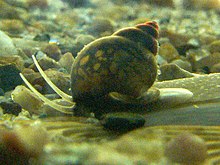
- Assimineidae - terrestrial (intermediate marine)
- Assiminea grayana Fleming, 1828
- Bithyniidae - aquatic
- Bithynia leachii (Sheppard, 1823)
- Bithynia tentaculata (Linnaeus, 1758)
- Hydrobiidae (mud snails) - aquatic (some are arguably marine)
- Hydrobia acuta neglecta Muus, 1963
- Hydrobia ventrosa (Montagu, 1803) = Ecrobia ventrosa
- Peringia ulvae (Pennant, 1777)
- Mercuria c.f. similis (Draparnaud, 1805) = Mercuria confusa (Frauenfeld, 1863)
- Potamopyrgus antipodarum (Gray, 1843) - introduced

- Valvatidae (valve snails) - aquatic
- Valvata cristata O. F. Müller, 1774
- Valvata piscinalis (O. F. Müller, 1774)
- Pomatiidae (land winkles) - terrestrial
- Pomatias elegans (Müller, 1774)
The following gastropods are pulmonates:
- Ellobiidae (hollow-shelled snails) - terrestrial or semi-marine
- Carychium minimum Müller, 1774
- Carychium tridentatum (Risso, 1826)
- Leucophytia bidentata (Montagu, 1808)
- Myosotella denticulata (Montagu, 1803)
- Myosotella myosotis (Draparnaud, 1801)
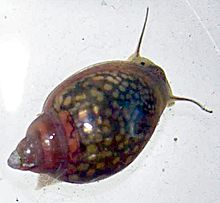
- Otinidae - aquatic (almost fully marine, but a pulmonate)
- Otina ovata (Brown, 1827)
- Physidae (bladder snails) - aquatic
- Aplexa hypnorum (Linnaeus, 1758)
- Physa fontinalis (Linnaeus, 1758)
- Physella acuta (Draparnaud, 1805) = Physella heterostropha (Say, 1817) - introduced
- Physella gyrina (Say, 1821) - introduced

- Lymnaeidae - aquatic
- Galba truncatula (O. F. Müller, 1774)
- Omphiscola glabra (O. F. Müller, 1774) - at one site in the south east of Ireland was found in 2009, but it is listed as extinct on a local red list (2009).[7]
- Lymnaea stagnalis (Linnaeus, 1758)
- Lymnaea fusca (C.Pfeiffer, 1821)
- Radix auricularia (Linnaeus, 1758)
- Radix balthica (Linnaeus, 1758)
- Radix peregra (Linnaeus, 1758)
- Myxas glutinosa (O. F. Müller, 1774)

- Planorbidae (ramshorn snails) - aquatic
- Planorbis carinatus O. F. Müller, 1774
- Planorbis planorbis (Linnaeus, 1758)
- Anisus leucostoma (Millet, 1813)
- Anisus vortex (Linnaeus, 1758)
- Anisus vorticulus (Troschel, 1834)
- Anisus spirorbis (Linnaeus, 1758)
- Bathyomphalus contortus (Linnaeus, 1758)
- Gyraulus laevis (Alder, 1838)
- Gyraulus albus (O. F. Müller, 1774)
- Gyraulus crista (Linnaeus, 1758)
- Hippeutis complanatus (Linnaeus, 1758)
- Planorbarius corneus corneus (Linnaeus, 1758)
- Ancylus fluviatilis O. F. Müller, 1774
- Acroloxidae (river limpets) - aquatic
- Acroloxus lacustris (Linnaeus, 1758)

- Succineidae (amber snails)- terrestrial (some almost amphibious)
- Quikella arenaria (Bouchard-Chantereaux, 1837) = Catinella arenaria
- Succinella oblonga Draparnaud, 1801
- Succinea putris Linnaeus, 1758
- Oxyloma elegans elegans (Risso, 1826) = Oxyloma pfeifferi (Rossmässler, 1835)
- Oxyloma sarsii (Esmark, 1886)
- Cochlicopidae - terrestrial
- Cochlicopa c.f. lubrica = Cochlicopa lubrica (O. F. Müller, 1774)
- Cochlicopa c.f. lubricella = Cochlicopa lubricella (Rossmässler, 1835)

- Pyramidulidae - terrestrial
- Pyramidula umbilicata (Montagu, 1803)
- Pyramidula pusilla (Vallot, 1801)
- Vertiginidae (whorl snails) - terrestrial
- Columella edentula Draparnaud, 1805)
- Columella aspera Walden, 1966

- Vertigo antivertigo (Draparnaud, 1801)
- Vertigo geyeri Lindholm, 1925
- Vertigo lilljeborgi (Westerlund, 1871)
- Vertigo moulinsiana (Dupuy, 1849)
- Vertigo pusilla O. F. Müller, 1774
- Vertigo pygmaea (Draparnaud, 1801)
- Vertigo substriata (Jeffreys, 1833)
- Vertigo angustior Jeffreys, 1830
- Pupillidae - terrestrial
- Pupilla muscorum (Linnaeus, 1758)
- Lauriidae - terrestrial
- Leiostyla anglica (Wood, 1828)
- Lauria cylindracea (da Costa, 1778)

- Valloniidae - terrestrial
- Vallonia costata (O. F. Müller, 1774)
- Vallonia pulchella (O. F. Müller, 1774)
- Vallonia c.f. excentrica = Vallonia excentrica Sterke, 1892
- Acanthinula aculeata (O. F. Müller, 1774)
- Spermodea lamellata (Jeffreys, 1830)

- Enidae - terrestrial
- Merdigera obscura = Ena obscura (O. F. Müller, 1774)
- Punctidae (dot snails) - terrestrial
- Punctum pygmaeum (Draparnaud, 1801)
- Discidae - terrestrial
- Discus rotundatus rotundatus (O. F. Müller, 1774)
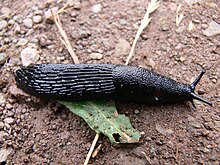
- Arionidae (roundback slugs) - terrestrial
- Arion ater (Linnaeus, 1758)
- Arion flagellus Collinge, 1893
- Arion vulgaris Moquin-Tandon, 1855 = (misapplied) Arion lusitanicus Mabille, 1868 - introduced
- Arion subfuscus Draparnaud, 1805 (if this is considered to be a separate taxon from A. fuscus)
- Arion fuscus (O.F. Müller, 1774)
- Arion circumscriptus Johnston, 1828
- Arion rufus (Linnaeus, 1758)
- Arion silvaticus Lohmander, 1937

- Arion fasciatus (Nilsson, 1823)
- Arion hortensis A. Férussac, 1819
- Arion distinctus J. Mabille, 1868
- Arion owenii Davies, 1979
- Arion intermedius (Normand, 1852)
- Arion occultus Anderson, 2004
- Geomalacus maculosus Allman, 1843
- Pristilomatidae - terrestrial
- Vitrea contracta (Westerlund, 1871)
- Vitrea crystallina (O. F. Müller, 1774)

- Euconulidae - terrestrial
- Euconulus c.f. fulvus (O. F. Müller, 1774) = Euconulus fulvus
- Euconulus c.f. alderi (J.E. Gray, 1840) = Euconulus alderi
- Gastrodontidae - terrestrial
- Zonitoides nitidus (O. F. Müller, 1774)
- Zonitoides excavatus (Alder, 1830)
- Oxychilidae - terrestrial
- Oxychilus alliarius (Miller, 1822)
- Oxychilus cellarius (O. F. Müller, 1774)
- Oxychilus draparnaudi draparnaudi (Beck, 1837) - introduced
- Oxychilus navarricus helveticus (Blum, 1881) - introduced
- Aegopinella nitidula (Draparnaud, 1805)
- Aegopinella pura (Alder, 1830)
- Nesovitrea hammonis (Ström, 1765) =Perpolita hammonis

- Milacidae - terrestrial
- Milax gagates (Draparnaud, 1801)
- Tandonia rustica (Millet, 1843)
- Tandonia budapestensis (Hazay, 1881)
- Tandonia sowerbyi (A. Férussac, 1823)
- Vitrinidae - terrestrial
- Vitrina pellucida (O. F. Müller, 1774)
- Semilimax pyrenaicus (A. Férussac, 1821) - introduced?


- Boettgerillidae - terrestrial
- Boettgerilla pallens Simroth, 1912 - introduced
- Limacidae (keelback slugs) - terrestrial
- Limax maximus Linnaeus, 1758
- Limax cinereoniger Wolf, 1803
- Limacus flavus (Linnaeus, 1758)
- Limax maculatus (Kaleniczenko, 1851) - introduced
- Lehmannia marginata (O. F. Müller, 1774)
- Lehmannia valentiana (A. Férussac, 1822)
- Agriolimacidae - terrestrial
- Deroceras laeve (O. F. Müller, 1774)
- Deroceras reticulatum (O. F. Müller, 1774)
- Deroceras invadens Reise, Hutchinson, Schunack & Schlitt, 2011 = Deroceras panormitanum (nec. sensu Lessona & Pollonera, 1882) = Deroceras caruanae (nec. sensu Pollonera, 1891)

- Ferussaciidae - terrestrial
- Cecilioides acicula (O. F. Müller, 1774)
- Clausiliidae (door snails) - terrestrial
- Cochlodina laminata (Montagu, 1803)
- Clausilia bidentata bidentata (Ström, 1765)
- Balea perversa (Linnaeus, 1758)
- Balea sarsii Pfeiffer, 1847
- Testacellidae (shelled slugs) - terrestrial
- Testacella maugei A. Férussac, 1822
- Testacella haliotidea Draparnaud, 1801
- Testacella scutulum Sowerby, 1821
- Cochlicellidae - terrestrial
- Cochlicella acuta (O. F. Müller, 1774)
- Hygromiidae - terrestrial

- Ashfordia granulata (Alder, 1830)
- Candidula gigaxii (L. Pfeiffer, 1850) - introduced
- Candidula intersecta (Poiret, 1801) - introduced
- Cernuella virgata (Da Costa, 1778) - introduced
- Helicella itala itala (Linnaeus, 1758)
- Hygromia cinctella (Draparnaud, 1801) - introduced
- Trochulus hispidus (Linnaeus, 1758)
- Trochulus striolatus (Pfeiffer, 1828) - indigenous?
- Zenobiella subrufescens (Miller, 1822)
- Helicidae (typical snails) - terrestrial
- Arianta arbustorum arbustorum (Linnaeus, 1758)
- Helicigona lapicida lapicida (Linnaeus, 1758)
- Theba pisana pisana (O. F. Müller, 1774) - introduced
- Cepaea nemoralis nemoralis (Linnaeus, 1758)
- Cepaea hortensis (O. F. Müller, 1774)
- Cornu aspersum aspersum = Helix aspersa (O.F. Müller, 1774) - introduced
Bivalvia
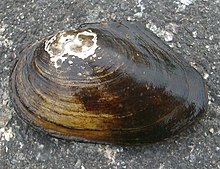
- Margaritiferidae - aquatic
- Margaritifera margaritifera (Linnaeus, 1758)

- Unionidae (river mussels) - aquatic
- Anodonta anatina (Linnaeus, 1758)
- Anodonta cygnea (Linnaeus, 1758)
- Sphaeriidae (pea clams, fingernail clams) - aquatic
- Sphaerium corneum (Linnaeus, 1758)
- Sphaerium nucleus (Studer, 1820)
- Musculium lacustre (O. F. Müller, 1774)
- Pisidium amnicum (O. F. Müller, 1774)
- Pisidium casertanum (Poli, 1791)
- Pisidium conventus (Clessin, 1877)
- Pisidium henslowanum (Sheppard, 1823)
- Pisidium hibernicum Westerlund, 1894
- Pisidium lilljeborgii (Clessin, 1886)
- Pisidium milium Held, 1836

- Pisidium moitessierianum Paladilhe, 1866
- Pisidium nitidum Jenyns, 1832
- Pisidium obtusale (Lamarck, 1818)
- Pisidium personatum Malm, 1855
- Pisidium pulchellum (Jenyns, 1832)
- Pisidium pseudosphaerium Favre, 1927
- Pisidium subtruncatum Malm, 1855
- Dreissenidae - aquatic
- Dreissena polymorpha (Pallas, 1771) - introduced
- Corbiculidae (basket clams)
- Corbicula fluminea (Müller, 1774)- introduced
List of "hothouse alien" species
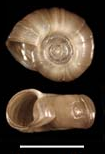
These freshwater species are not truly part of the fauna, because they do not live in the wild. They are tropical, and thus are incapable of surviving in the wild in Ireland; instead they have established themselves as uninvited inhabitants of aquaria within greenhouses, and similar artificially-heated aquatic habitats.
- Lymnaeidae - aquatic
- Radix rubiginosa (Michelin, 1831), native to Indo-China and Indonesia
- Planorbidae - aquatic
- Planorbella duryi (Wetherby, 1879)
See also
- List of marine molluscs of Ireland
- Biota of the Isle of Man#Mollusca (molluscs)
- List of non-marine molluscs of Great Britain
- List of non-marine molluscs of the Netherlands
References
- Anderson, R. (2005). "An annotated list of the non-marine molluscs of Britain and Ireland". Journal of Conchology. 38 (6): 607–637. ISSN 1753-2205.
- (7 January 2009). Checklist of protected & rare species in Ireland[permanent dead link]. 15 pp., page 12.
- Byrne A., Moorkens E. A., Anderson R., Killeen I. J. & Regan E. C. (2009). [permanent dead link] Ireland Red List No. 2 – Non-Marine Molluscs. National Parks and Wildlife Service, Department of the Environment, Heritage and Local Government, Dublin, Ireland.
- IUCN (2003) Guidelines for Application of IUCN Red List Criteria at Regional Levels: Version 3.0. IUCN Species Survival Commission. IUCN, Gland, Switzerland & Cambridge, UK. ii + 26 pp.
- (January 2009). "Third of snail species here threatened with extinction". The Irish Times.
- "Little sand-bowl arrow snail at the point of no return".
- Anderson R. (2009). "Value of species datasets as baselines (non-marine Mollusca)" Archived 24 July 2011 at the Wayback Machine. accessed 31 July 2010.
- Kerney, Michael, 1999, Atlas of the land and freshwater molluscs of Britain and Ireland, Harley Books, Colchester, England, ISBN 0-946589-48-8.
- Hayden, B. & Caffrey, J.M. 2013 First recording of the Asian clam (Corbicula fluminea (Müller, 1774)) from the River Shannon, with preliminary notes on population size and size class distribution. Irish Naturalists' Journal 32: 29-31
Further reading
- Scharff, R. F. 1896. The slugs of Ireland. London.
- Rev. Canon J.W. Horsley Our British snails. London :Society for Promoting Christian Knowledge,1915. pdf (BHL) Beginners text and plates
- George Brettingham Sowerby Illustrated Index of British Shells (1859) s:Illustrated Index of British Shells Wikisource full text and plates
- Germain, L. Faune de France n° 21 Mollusques terrestres et fluviatiles. vol I. 1930, 478 p.pdf
- Germain, L. Faune de France n° 22 Mollusques terrestres et fluviatiles. vol. II. 1931, 520 p. 390 fig.pdf
- Germain, L. Illustrations des Faunes n° 21-22 Mollusques terrestres et fluviatiles pdf
- Francisco Welter-Schultes, 2012. European non-marine molluscs, a guide for species identification. Bestimmungsbuch für europäische Land- und Süsswassermollusken. Planet Poster Editions, Göttingen.ISBN 978-3-933922-75-5
- George Washington Tryon article lists all parts of Manual of conchology 1887-1935 with online links.
- George W. Tryon, Jr., Henry Augustus Pilsbry and B. Sharp Manual of conchology, structural and systematic : with illustrations of the species Philadelphia :Published by the Author, Academy of Natural Sciences,1879-1898 Series 1 17 volumes online here
- George W. Tryon, Jr.,Horace Burrington Baker, Charles Montague Cooke, Alpheus Hyatt, Henry Augustus Pilsbry, Manual of conchology, structural and systematic : with illustrations of the species. by George W. Tryon, Jr. Second series, Pulmonata Philadelphia :Published by the Author,1885-1935. 28 volumes and indices online here
External links
- An annotated list of the non-marine molluscs of Britain and Ireland
- The Living World of Snails Robert Nordsieck Austria Highly recommended site
- MolluscIreland
- Invertebrate Ireland Online Partially illustrated checklist
- Northern Ireland's Priority Species & Species of Conservation Concern. Molluscs.
- Conchological Society Identification help.
- BDH Taylor, John William, Roebuck, William Denison and Ashford, Charles, 1829-1894 Monograph of the land & freshwater Mollusca of the British isles Leeds, Taylor Brothers Parts 8 -24. (all parts U.S. Archive
- National Biodiversity Network Species distribution maps
- Irish Biodiversity Maps - including non-marine molluscs
- Molluscs of Central Europe Taxonomy. Images
- L. Watson and M. J. Dallwitz The families of British non-marine molluscs (slugs, snails and mussels)
- Mollusca Slovenska Ecology Distribution (in text)
| Wikisource has original text related to this article: |
Другой контент может иметь иную лицензию. Перед использованием материалов сайта WikiSort.org внимательно изучите правила лицензирования конкретных элементов наполнения сайта.
WikiSort.org - проект по пересортировке и дополнению контента Википедии